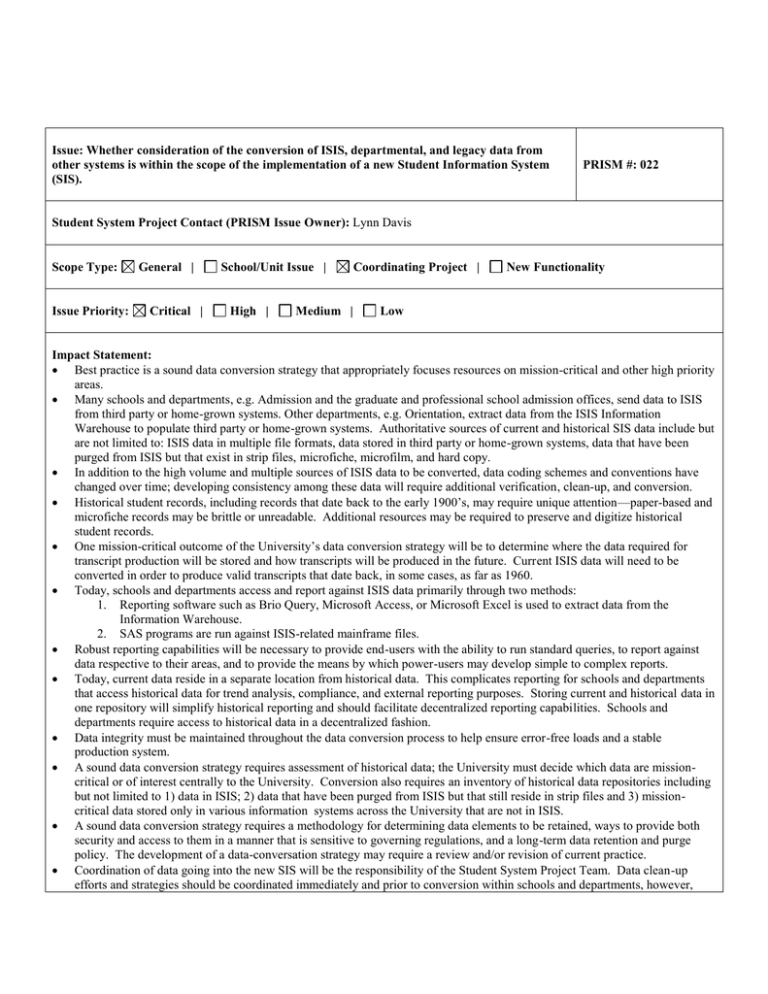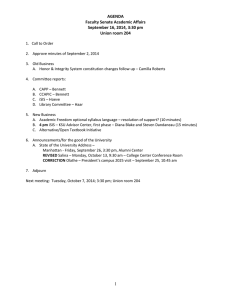Consideration of the conversion of ISIS, departmental, and legacy data
advertisement

Issue: Whether consideration of the conversion of ISIS, departmental, and legacy data from other systems is within the scope of the implementation of a new Student Information System (SIS). PRISM #: 022 Student System Project Contact (PRISM Issue Owner): Lynn Davis Scope Type: Issue Priority: General | Critical | School/Unit Issue | High | Medium | Coordinating Project | New Functionality Low Impact Statement: Best practice is a sound data conversion strategy that appropriately focuses resources on mission-critical and other high priority areas. Many schools and departments, e.g. Admission and the graduate and professional school admission offices, send data to ISIS from third party or home-grown systems. Other departments, e.g. Orientation, extract data from the ISIS Information Warehouse to populate third party or home-grown systems. Authoritative sources of current and historical SIS data include but are not limited to: ISIS data in multiple file formats, data stored in third party or home-grown systems, data that have been purged from ISIS but that exist in strip files, microfiche, microfilm, and hard copy. In addition to the high volume and multiple sources of ISIS data to be converted, data coding schemes and conventions have changed over time; developing consistency among these data will require additional verification, clean-up, and conversion. Historical student records, including records that date back to the early 1900’s, may require unique attention—paper-based and microfiche records may be brittle or unreadable. Additional resources may be required to preserve and digitize historical student records. One mission-critical outcome of the University’s data conversion strategy will be to determine where the data required for transcript production will be stored and how transcripts will be produced in the future. Current ISIS data will need to be converted in order to produce valid transcripts that date back, in some cases, as far as 1960. Today, schools and departments access and report against ISIS data primarily through two methods: 1. Reporting software such as Brio Query, Microsoft Access, or Microsoft Excel is used to extract data from the Information Warehouse. 2. SAS programs are run against ISIS-related mainframe files. Robust reporting capabilities will be necessary to provide end-users with the ability to run standard queries, to report against data respective to their areas, and to provide the means by which power-users may develop simple to complex reports. Today, current data reside in a separate location from historical data. This complicates reporting for schools and departments that access historical data for trend analysis, compliance, and external reporting purposes. Storing current and historical data in one repository will simplify historical reporting and should facilitate decentralized reporting capabilities. Schools and departments require access to historical data in a decentralized fashion. Data integrity must be maintained throughout the data conversion process to help ensure error-free loads and a stable production system. A sound data conversion strategy requires assessment of historical data; the University must decide which data are missioncritical or of interest centrally to the University. Conversion also requires an inventory of historical data repositories including but not limited to 1) data in ISIS; 2) data that have been purged from ISIS but that still reside in strip files and 3) missioncritical data stored only in various information systems across the University that are not in ISIS. A sound data conversion strategy requires a methodology for determining data elements to be retained, ways to provide both security and access to them in a manner that is sensitive to governing regulations, and a long-term data retention and purge policy. The development of a data-conversation strategy may require a review and/or revision of current practice. Coordination of data going into the new SIS will be the responsibility of the Student System Project Team. Data clean-up efforts and strategies should be coordinated immediately and prior to conversion within schools and departments, however, with guidance from knowledgeable partners. The University should be prepared for the likelihood that not all data can be converted automatically. In some cases, manual labor intensive conversion efforts will be necessary and will require additional resources. The University may need to consider alternative data management strategies during the implementation of a new SIS. Options and Implications: 1. 2. The consideration of the conversion of ISIS, departmental and legacy data is outside the scope of the implementation of a new SIS. In this option, the Student System Project team resources will be devoted to mission-critical, high priority areas and to providing a means by which departments can convert their own data. The consideration of the conversion of ISIS, departmental and legacy data is within the scope of the implementation of a new SIS. In this option, the University would have to define the extent of data conversion, identify appropriate sources of expertise, define hardware requirements, and commit resources to implement the necessary conversions. Recommendation: Option 2: The consideration of the conversion of ISIS, legacy and departmental data is within the scope of the implementation of a new SIS. The Student System Project team will assist departmental areas to determine the extent and the means by which to convert their data appropriately. Dependencies: The desire of the University to develop a conversion strategy which will meet the historical reporting needs of the schools and departments and also ensure the highest level of data integrity in the new student system. The University’s desire to devote resources to the centralization of ISIS, legacy and departmental data. The development of protocol(s) that provides for removal of the Social Security Number as the key identifier within the student information system. The life expectancy of the current mainframe is expected to be a minimum of at least one year after the last phase of the Student System Project has been completed. The expectation is that all data will be archived or off-loaded by the time it is shut down. Next Steps (if in scope): Convene a working group and identify appropriate external experts to determine the scope of data conversion and assess the feasibility of converting all current data in ISIS and/or the ISIS Warehouse. This working group should develop a strategy and define resource requirements for data mapping, legacy data cleanup, data conversion, data consolidation and data storage and should develop contingency plans to store existing data in the event problems are discovered later in the conversion process. The Student System Project Team will coordinate and provide the means for moving data into the new student system and will assume responsibility for converting legacy data from ISIS, the Information Warehouse, and appropriate mainframe files. As a data conversion strategy is developed, it will be conceived as part of a comprehensive reporting strategy. Deadline for Executive Committee: Decision by Executive Committee: Option 2: The consideration of the conversion of ISIS, legacy and departmental data is within the scope of the implementation of a new SIS. The Student System Project team will assist departmental areas to determine the extent and the means by which to convert their data appropriately. Executive Committee Reviewer/Approver: Full IS Executive Committee Signature of Reviewer: Gene Block Date: March 22, 2006


